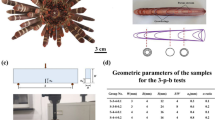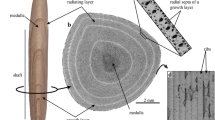Abstract
Sea urchin spines were chosen as a model system for biomimetic ceramics obtained using starch-blended slip casting. Porous alumina ceramics with cap-shaped layers with different alternating porosities were found to have superior fracture behavior under bulk compression compared to ceramics with uniform porosity. They fail in a cascading manner, absorbing high amounts of energy during extended compression paths. The porosity variation in an otherwise single phase material mimicks the architectural microstructure design of sea urchin spines of Heterocentrotus mammillatus, which are promising model materials for impact protection.
Similar content being viewed by others
References
Weber J N. Incorporation of magnesium into the skeletal calcites of echinoderms. American Journal of Science, 1969, 267, 537–566.
Presser V, Schultheiß S, Berthold C, Nickel K G. Sea urchin spines as a model-system for permeable, light-weight ceramics with graceful failure behavior. Part I. Mechanical behavior of sea urchin spines under compression. Journal of Bionic Engineering, 2009, 6, 203–213.
Davis J B, Kristoffersson A, Carlström E, Clegg W J. Fabrication and crack deflection in ceramic laminates with porous interlayers. Journal of the American Ceramic Society, 2000, 83, 2369–2374.
Tu W-C, Lange F F, Evans A G. Concept for a damage-tolerant ceramic composite with “strong” interfaces. Journal of the American Ceramic Society, 1996, 79, 417–424.
Goller R, Kleer G, Kriegesmann J. Bruchmechanische Untersuchungen an laminiertem siliciuminfiltriertem Siliciumcarbid (SiSiC). Keramische Zeitschrift, 1994, 46, 156–158. (in Germany)
Yu Z B, Krstic V D. Fabrication and characterization of laminated SiC ceramics with self-sealed ring structure. Journal of Materials Science, 2003, 38, 4735–4738.
Krstic Z, Krstic V D. Young’s modulus, density, and phase composition of pressureless sintered self-sealed Si3N4/BN laminated structures. Journal of the European Ceramic Society, 2008, 28, 1723–1730.
Gregorova E, Zivcova Z, Pabst W. Porosity and pore space characteristics of starch-processed porous ceramics. Journal of Materials Science, 2006, 41, 6119–6122.
Bargel H-J, Schulze G. Werkstoffkunde, Springer, Berlin, 2008. (in Germany)
Delesse A. Procédé mècanique pout déterminer la composition des roches. Annales des Mines, 1848, 4, 379–388. (in French)
Rosiwal A K. Über geometrische Gesteinsanalysen. Ein einfacher Weg zur ziffernmäßigen Feststellung der Quantitätsverhältnisses der Mineralbestandteile gemengter Gesteine. Verhandlungen der Geologischen Reichsanstalt Wien, 1898, 15, 143–175. (in Germany)
Russ J C, Dehoff R T. Practical Stereology, Springer, New York, 2001.
Hampton J H D, Savage S B, Drew R A L. Experimental analysis and modeling of slip casting. Journal of the American Ceramic Society, 1988, 71, 1040–1045.
Gregorová E, Pabst W, Bohacenko I. Characterization of different starch types for their application in ceramic processing. Journal of the European Ceramic Society, 2006, 26, 1301–1309.
Nanjangud S C, Brezny R, Green D J. Strength and Young’s modulus behavior of a partially sintered porous alumina. Journal of the American Ceramic Society, 1995, 78, 266–268.
Ham-Su R, Wilkinson D S. Strength of tape cast and laminated ceramics. Journal of the American Ceramic Society, 1995, 78, 1580–1584.
Author information
Authors and Affiliations
Corresponding author
Rights and permissions
About this article
Cite this article
Presser, V., Kohler, C., Živcová, Z. et al. Sea Urchin Spines as a Model-System for Permeable, Light-Weight Ceramics with Graceful Failure Behavior. Part II. Mechanical Behavior of Sea Urchin Spine Inspired Porous Aluminum Oxide Ceramics under Compression. J Bionic Eng 6, 357–364 (2009). https://doi.org/10.1016/S1672-6529(08)60143-2
Published:
Issue Date:
DOI: https://doi.org/10.1016/S1672-6529(08)60143-2




